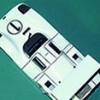Carbon fibre driveshafts now seem to be commonplace and the technology of fixing the CF tube onto a metallic UJ yoke seems reliable.
So why not a fully CF rigid axle with just metallic parts for the hubs and gears?
The half shafts can clearly be CF even if they may need to be quite large diameter. The axle tubes can be CF with alloy outer hubs for bearings and caliper attachment.
The central diff. casing can also be moulded CF and probably mated to the CF outer tubes by rings or adhesive bonding. Being custom made negative camber can be designed in.
Rigid axles have their limitations of swing arm length equals track and inner tyre tilt but most IRS with an ARB moves the inner wheel angle too.
Arthur Mallock showed with his " trailing arm magic" just how good a well designed axle can be. A Mumford link allowed a rear RC wherever you want it and the non equal and non parallel trailing arms countered squat and cross axle weight transfer.
Also it is often much easier and liighter to design the well spread out solid axle attachment points than closely positioned IRS links near the car centre line.













